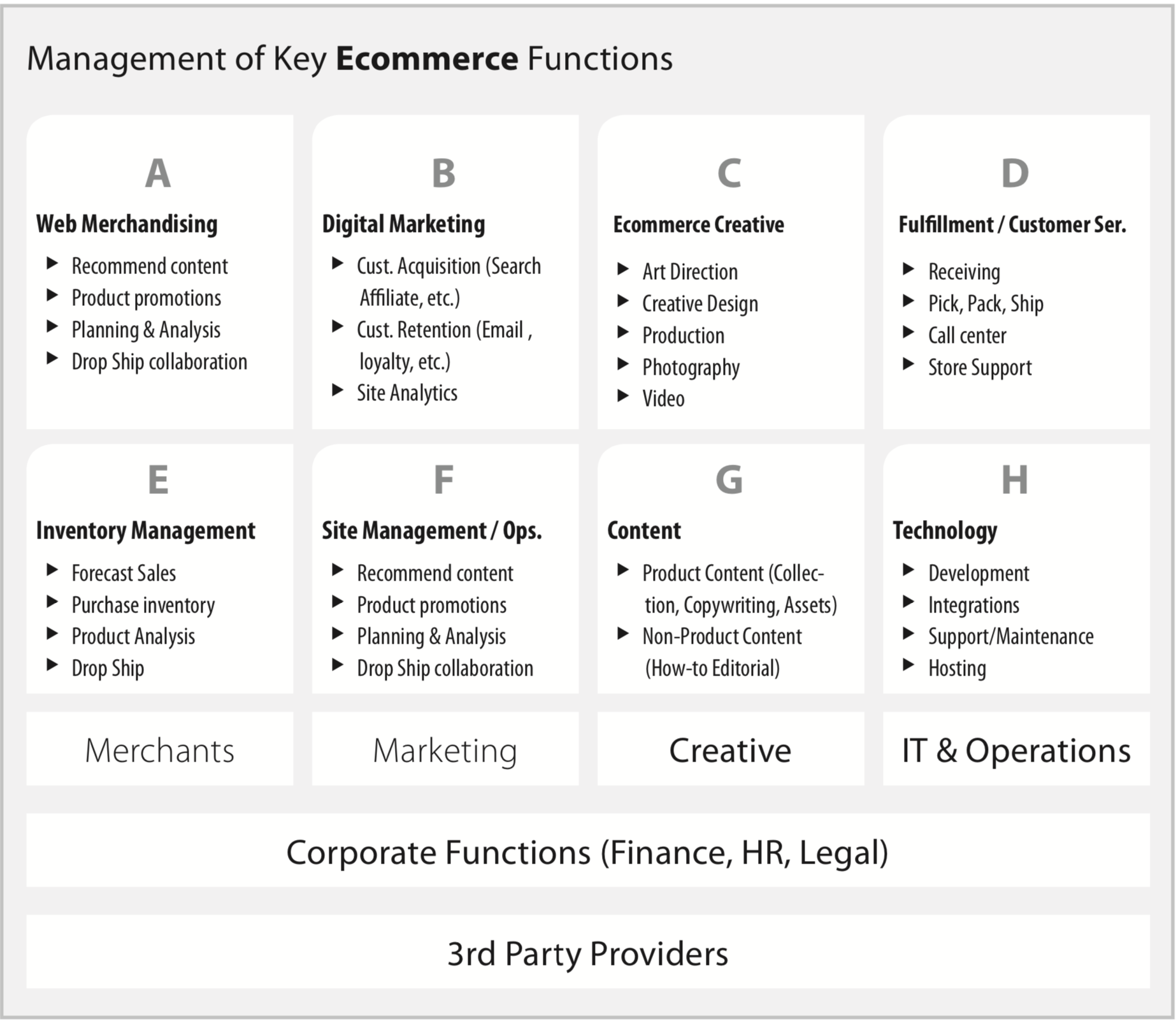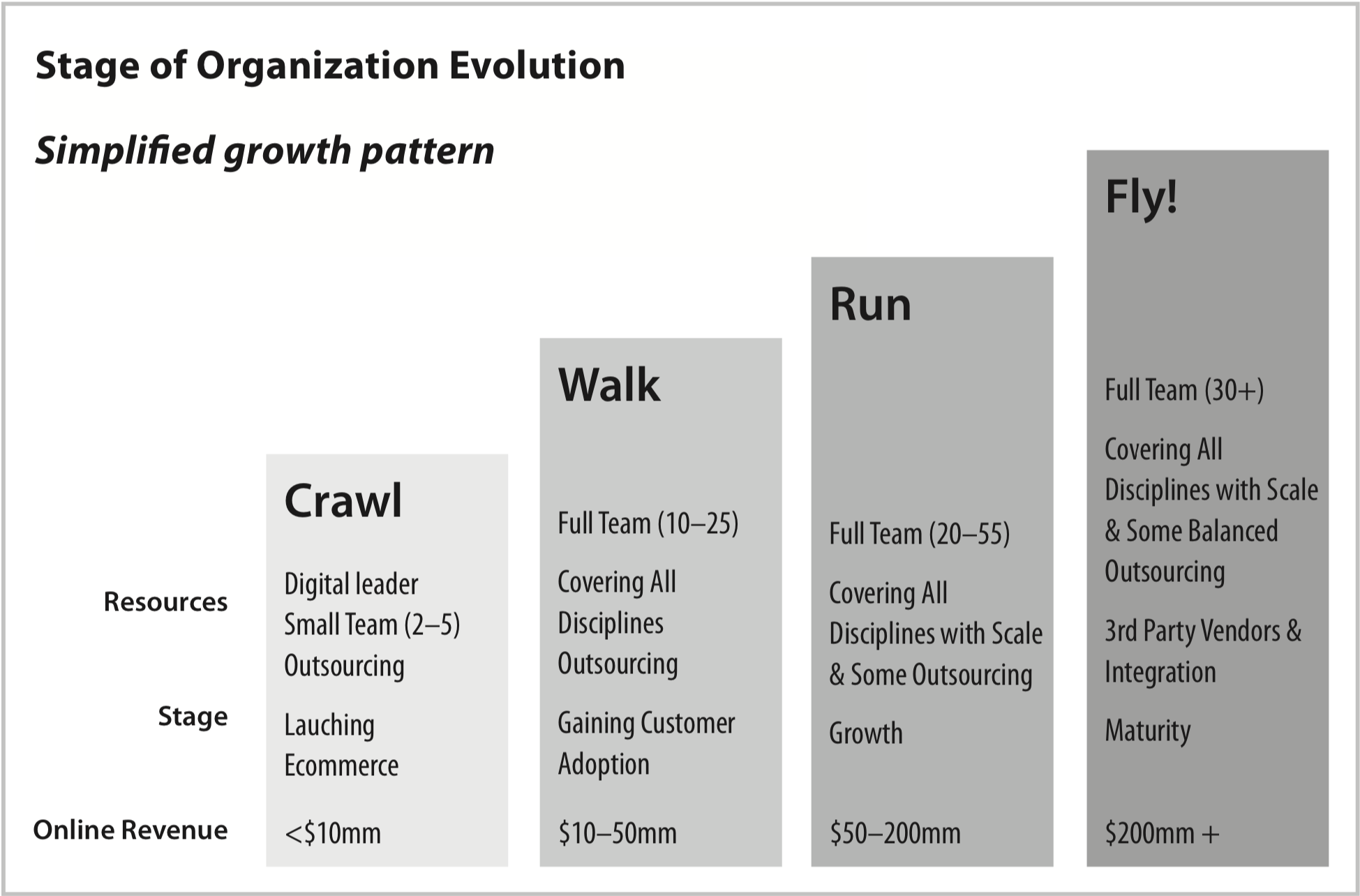Forming a Successful B2B E-Commerce Organization: Part 4 of 8

Because e-commerce touches every part of the company, establishing an e-commerce operation requires firms to evolve how they are structured, creating new roles and responsibilities.
Success lies in strategically linking all roles and functions together, integrating them into the organization tactically.
Firms new to e-commerce should take a crawl-walk-run-fly approach that gradually and carefully introduces e-commerce to the firm’s employees and customers. This will ensure long-term success while minimizing disruption.
Organizations should see digital transformation as an evolution—not a revolution—and develop a long-term plan to build their e-commerce operation.
I am partnering with fabric this Fall season to revisit concepts in my book Billion Dollar B2B E-Commerce and reflect on how organizations approached these concepts during the height of COVID-19 that pushed more business online. This is part four of an eight-part series.
B2B e-commerce is an evolution, not a revolution. Many B2B companies aim to hit the ground running when it comes to generating sales online, but launching and operating a successful e-commerce platform doesn’t happen overnight.
Whenever I get the opportunity to work with B2B firms that are motivated and excited about digitally transforming their organizations, management and executives are reminded that the process is a marathon—not a sprint. Therefore, they must temper their expectations on how quickly they will achieve satisfactory results. Simply put, there is no magic button that anyone can push that will suddenly cause a business to grow by triple digits.
However, there are many ways to accelerate growth and avoid setbacks, which is why putting together an e-commerce organization the right way is critical for sustained long-term growth. Many B2B companies—especially firms that have been around before the invention of the internet—do not have any existing e-commerce expertise or competency within the organization. Obtaining the incremental revenue and efficiencies available through e-commerce is an exciting prospect but takes time – and the right people – to develop.
In this post, I will discuss the roles and functions a company needs, how to determine which ones to outsource and which ones to insource, and how to build out competencies in these areas.
[toc-embed headline=”Critical Organizational Roles for E-Commerce Success”]
Critical Organizational Roles for E-Commerce Success
So what are the roles and functions an organization needs for e-commerce success? The chart below shows the roles I have found necessary across organizations with a high degree of digital competency, both in business-to-consumer (B2C) and business-to-business (B2B) firms.

You may notice that most B2B organizations already have teams or departments that cover many of these operations. However, e-commerce functions require distinct skill sets and expertise that traditional departments may not have. For example, a digital marketing team will likely specialize in search engine optimization (SEO), paid search, digital display advertising, email marketing, social media marketing, affiliate marketing, and loyalty programs, to name a few.
You may have also noticed that I didn’t mention the sales role in any of these functions. That in no way implies that sales is not important; in fact, alignment and support from the sales function is integral to B2B e-commerce success. This is why I’ve devoted the next post in this series to discuss the impact of e-commerce on the sales process and how e-commerce can be a game-changer for this function when aligned properly. Click here to the next part in this series.
[toc-embed headline=”Bringing the Team Together”]
Bringing the Team Together
For management trying to promote change in their organization, it is not enough to just create the functions listed above and expect them to operate at their full potential. As mentioned previously, digital transformation requires a shift in cultural mindset; every organization needs to build a collaborative framework that holds teams accountable and drives changes in thinking and process. This is the most challenging part of developing an e-commerce business.
The key to success is linking all functions together with a clearly communicated vision, specific goals, and metrics. This requires leadership from the top and spreading the responsibility for success across the entire company. It is important to note that this is the one thing a third-party vendor can never accomplish; this shift has to happen from inside the organization.
The good news is that you don’t have to build a huge team right away. The crawl-walk-run-fly approach works in organizational development, as it does to the entire e-commerce development process. The trick is finding the two or three things your organization does masterfully and then outsourcing the rest (at least at the beginning). However, note that you still need to have someone in a leadership role internally leading the charge, communicating vision and strategy, and being held accountable for results.
The following graphic highlights the stages of organizational development for B2B firms, following a crawl-walk-run-fly paradigm, where “flying” represents a true digitally transformed business.

For many necessary functions of e-commerce, such as digital marketing, technology, and even fulfillment, third parties can help you accelerate your efforts without incurring high fixed costs. I typically recommend looking to outsource the following functions at the “crawl” phase:
- Website development (technology) and hosting
- Website design and ongoing creative
- Digital marketing
- Some website management (e.g., UX optimization, analytics, and testing activities)
Evolution Not Revolution
The most important thing to remember in all of this is not to boil the ocean right away. Doing too much at once is a recipe for failure. Many B2B organizations are steeped in history and have earned success with well-established processes and relationships.
E-commerce challenges these traditional ways of doing business. As a result, an evolution—versus a revolution—is a more appropriate approach for many companies. Developing a plan is a key step toward ensuring a successful digital transformation. You cannot expect to build a well-oiled B2B e-commerce engine overnight.
Like anything else in business, success will involve a combination of hard work and patience. Stick with it. With enough planning, commitment, and elbow grease, your company can reap the benefits of e-commerce. The opportunity is available to you, and a careful balance of thoughtful leadership and planning will lead to the gradual changes needed to capture the benefits for your company.
– Billion Dollar B2B E-Commerce, Chapter 4, Page 107, First Edition

B2B e-commerce expert and author of Billion Dollar B2B E-Commerce.